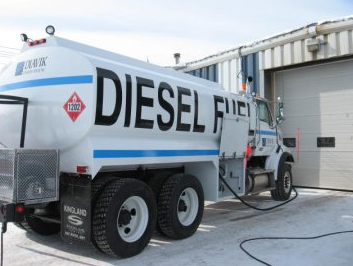Gas revolution may close price gap with oil
 Courtesy of Arab Times by John Kemp: Diesel is now six times more expensive than natural gas on an energy-equivalent basis in the US, a gap that is unsustainable.
Courtesy of Arab Times by John Kemp: Diesel is now six times more expensive than natural gas on an energy-equivalent basis in the US, a gap that is unsustainable.
As Herbert Stein, chief economist to President Richard Nixon noted, if something cannot go on forever, it will stop. But how and when the gap closes is the single most important question facing oil and gas consumers around the world.
The financial incentive to substitute gas for oil is enormous. Cheap gas has already started to transform America’s industrial landscape and transportation system.
On a global level, two parallel transformations are underway. A world gas market is slowly emerging as increasing volumes of seaborne LNG integrate the current system of separate national and regional prices. And the gas market is gradually becoming more integrated with oil as more users switch to gas.
 Half of all refuse trucks sold in the US last year run on gas. Chinese firm ENN Group has opened five public refueling stations for gas-powered trucks and plans to open 50 by the end of the year. Ventures backed by Chesapeake and Shell plan hundreds more.
Half of all refuse trucks sold in the US last year run on gas. Chinese firm ENN Group has opened five public refueling stations for gas-powered trucks and plans to open 50 by the end of the year. Ventures backed by Chesapeake and Shell plan hundreds more.
On the railways, Burlington Northern-Santa Fe (BNSF), the second-largest buyer of diesel in the country after the US Navy, has revived plans for gas-powered trains. BNSF could convert its entire fleet of 6,900 locomotives to run on a mix of diesel and up to 90 percent gas if the pilot is a success. Other Class 1 railroads such as Norfolk Southern and Union Pacific are partnering with locomotive manufacturers on the same idea.
Gas is also starting to replace diesel in a range of industrial engines. Oilfield services company Halliburton has converted some of the pressure pumping equipment it uses for hydraulic fracturing to run on a gas/diesel mix. Major engine manufacturers including Caterpillar, General Electric and Wartsila are marketing dual-fuel motors and retrofitting kits.
In manufacturing, companies making energy-intensive products including chemicals, fertilizers, steel, aluminum, tires, plastics and glass have announced 107 major new investments in the United States totaling $95 billion that will use up to 6 billion cubic feet of extra gas per day, raising industrial gas consumption by about a third.
The full list is contained in a letter from the Industrial Energy Consumers of America (IECA) to the Department of Energy that argues against the approval of gas exports.
Not all these projects have reached a final investment decision. But this week Austrian steelmaker Voestalpine became the latest company to confirm it will build a big new gas-fired plant, in this case to produce sponge iron, to take advantage of cheap gas in Texas, among other considerations.
Voestalpineís chief executive noted that natural gas prices on the Texas coast were about a quarter of those in Europe. “It would have been impossible to build a comparable plant in the European Union, not least because of a lack of competitiveness in terms of operating costs.”
Others are trying to exploit the differential between gas and oil prices by building Fischer-Tropsch plants to convert gas into higher-priced diesel and jet fuel or applying for US licenses to export liquefied natural gas (LNG) to markets in Europe and Asia, where gas commands a price nearer to crude.
Sasol has announced plans to build a gas-to-liquids (GTL) plant in Louisiana. Shell is reportedly examining a similar project in Louisiana or Texas. And the US Department of Energy has received applications from 25 companies to export nearly 30 billion cubic feet of gas per day as LNG, more than 40 percent of what the country presently consumes.
The gas revolution is furthest advanced in North America, where hydraulic fracturing has had the biggest impact on gas output and the gap between gas and refined product prices is widest. But it is starting to be felt even in regions where the gas industry is relatively immature and fracturing has yet to be widely used.
China had 1.48 million vehicles driving on natural gas in 2012, up 48 percent from 2011 and a huge jump from just 6,000 in 2000. The vehicles, mainly taxis, buses and trucks, in parts of the country with abundant gas resources but far from the main cities on the east coast, run on compressed natural gas (CNG) as well as LNG.
China’s government has targeted its enormous transport sector as a preferred user of natural gas. More than 30 automakers make gas-fueled vehicles, and gas could reduce projected oil demand nearly 10 percent by 2030, according to a study from consultants Wood Mackenzie.
Japan, which imports nearly all its gas as LNG on contracts indexed to the price of oil, has started to push for amended terms that would align pricing more closely with lower prices in Europe and especially the US.It is very unlikely gas prices will ever be completely equalized across regional markets or on an energy-equivalent basis with crude.
prices will ever be completely equalized across regional markets or on an energy-equivalent basis with crude.
But the current wide variations are unsustainable. The increase in LNG capacity, the relocation of heavy manufacturing activity and the shift to cheaper gas in the transport sector will all help arbitrage some of the price differentials away. Like all the interesting questions in economics, it is impossible to know whether the gap will close through a rise in the price of gas, a fall in oil, or some combination of the two. It is also impossible to know how much of oil’s current share of the transport market will eventually be lost to gas.
If one company converts to using gas, while everyone else sticks to oil, it would derive an enormous economic advantage. If everyone converts, rising gas prices will quickly ensure no one benefits. The right strategy depends on what everyone else does, which is unknowable in advance. Converting up to economy-level, if all the proposed new manufacturing plants in the US are built, all the LNG export applications are approved, all the railroads convert to gas and a substantial chunk of the trucking market coverts to LNG or CNG, surging demand for gas will quickly eliminate any competitive advantage from conversion.
But if everyone sticks to oil, fearing that the advantages of conversion will be fleeting, the price gap will remain and the conversion benefits will remain for anyone bold enough to take the risk. For large industrial energy users that move soon, it may be possible to offset some of this uncertainty by taking an equity stake in new gas fields or reaching other long-term supply arrangements.
Steelmaker Nucor is taking a 50 percent working interest in onshore gas wells drilled and operated by Encana to help protect its expansion of US iron and steel-making capacity, for example.
The indeterminate nature of the transition has fueled a fierce fight over whether the US Department of Energy should approve applications for large-scale LNG exports. In an assessment of the economic impact of LNG exports commissioned by the department, NERA Economic Consulting concluded exports would have a limited effect on domestic prices and provide net benefits to the economy under all the scenarios considered (‘Macroeconomic impact of LNG exports from the United States’ Dec 2012).
In its response, the Industrial Energy Consumers of America claims the study underestimates the potential growth in domestic gas consumption from the industrial, power generation and transport sectors in the years ahead. The study is flawed, from IECA’s perspective, because it performed an essentially static analysis that failed to take into account the massive amount of new gas demand already being stimulated by low prices.
Gas producers and consumers want widely different approaches to resolve this indeterminacy. Producers advocate leaving it up to the market to auction the gas to the highest bidder. IECA wants the government to step in and reserve the gas for domestic users, even if international customers would pay more.
It comes down to an argument between those who favor free markets to guide investment and those who want an active industrial policy based on protectionism. In the meantime, uncertainty about how and when oil and gas prices will re-connect will drive big profits for those companies that make the right (or just lucky) call.
Category: Fuel & Oil, General Update, Transit News










